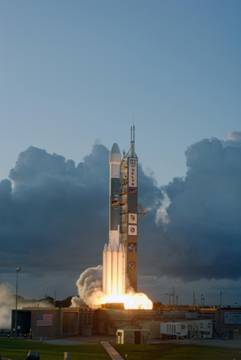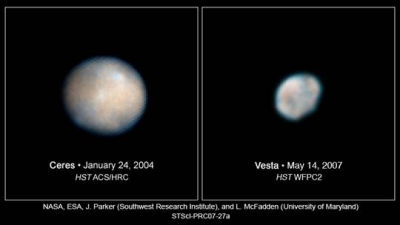28 September 2007

Credit: NASA/Sandra Joseph and Rafael Hernandez
On 27 September 2007, NASA launched the Dawn spacecraft into the asteroid belt. Dawn will explore Vesta (530 km across), one of the largest asteroids, and Ceres (about 950 km across), the smallest dwarf planet. This is the first mission ever in which a single spacecraft orbits two Solar System objects.
Dawn was launched aboard the powerful Delta 2 rocket. The launch occurred at 11:34 GMT, from the Cape Canaveral Air Force Station. About 2 hours after launch, ground controllers at NASA's Jet Propulsion Laboratory (JPL) received signals from Dawn indicating that the spacecraft had been properly oriented in space and its massive solar array was generating power from the Sun.
"Dawn has risen, and the spacecraft is healthy," said the mission's project manager Keyur Patel of JPL. "About this time 28 September 2007, we will have passed the Moon's orbit."
Over the next 80 days, spacecraft controllers will examine the spacecraft systems and subsystems, ensuring Dawn is ready for its 5-billion-km journey ahead.
Vesta and Ceres orbit the Sun between the orbits of Mars and Jupiter. Ceres orbits the Sun at an average distance of approximately 415 million km. Its orbital period is nearly 4.6 years. Vesta orbits the Sun at an average distance of approximately 353 million km, with an orbital period of about 3.6 years.
Dawn is expected to arrive at Vesta in August 2011, and Ceres in February 2015. The spacecraft is scheduled to orbit Vesta for 9 months, and orbit Ceres for at least 5 months. En route to Vesta, Dawn will fly by Mars in February 2009, for a "gravity assist".

The spacecraft's engines feature an innovative technique, hyper-efficient system known as ion propulsion, which electrically ionizes xenon to generate thrust. The 30-cm-wide ion thrusters provide less power than conventional engines but can sustain thrust for months at a time.
Sophisticated instruments onboard Dawn will measure elemental and mineral composition, shape, surface topography, and tectonic evolution, and will also search for water-bearing minerals. The trajectories of Dawn around Vesta and Ceres will enable the masses and gravitational fields of the objects to be computed.
"Dawn will travel back in time by probing deep into the asteroid belt," said Dawn Principal Investigator Christopher Russell, University of California. "This is a moment the space science community has been waiting for since interplanetary spaceflight became possible."
The asteroids are believed to be primitive material, left over from the primordial solar nebula in which the Solar System was born. Scientists expect that studying the two varied objects from a close range will yield valuable clues to the origin and formation of the Solar System.
Further Reading
Dawn Websites
http://dawn.jpl.nasa.gov/
http://www.nasa.gov/dawn
Aymen Mohamed Ibrahem
Senior Astronomy Specialist